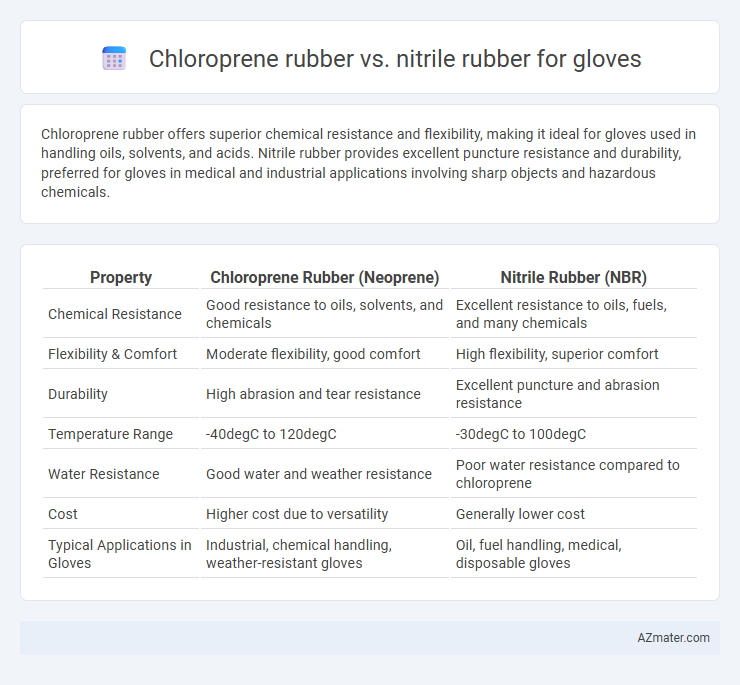Chloroprene rubber offers superior chemical resistance and flexibility, making it ideal for gloves used in handling oils, solvents, and acids. Nitrile rubber provides excellent puncture resistance and durability, preferred for gloves in medical and industrial applications involving sharp objects and hazardous chemicals.
Table of Comparison
| Property | Chloroprene Rubber (Neoprene) | Nitrile Rubber (NBR) |
|---|---|---|
| Chemical Resistance | Good resistance to oils, solvents, and chemicals | Excellent resistance to oils, fuels, and many chemicals |
| Flexibility & Comfort | Moderate flexibility, good comfort | High flexibility, superior comfort |
| Durability | High abrasion and tear resistance | Excellent puncture and abrasion resistance |
| Temperature Range | -40degC to 120degC | -30degC to 100degC |
| Water Resistance | Good water and weather resistance | Poor water resistance compared to chloroprene |
| Cost | Higher cost due to versatility | Generally lower cost |
| Typical Applications in Gloves | Industrial, chemical handling, weather-resistant gloves | Oil, fuel handling, medical, disposable gloves |
Introduction to Chloroprene and Nitrile Rubber Gloves
Chloroprene rubber gloves offer excellent chemical resistance and durability, making them ideal for environments requiring protection against oils, acids, and alkalis. Nitrile rubber gloves provide superior puncture resistance and are highly effective against a wide range of solvents and petroleum-based products. Both materials deliver strong barrier protection, with chloroprene excelling in flexibility and nitrile offering enhanced allergy safety due to its latex-free composition.
Chemical Structure and Composition
Chloroprene rubber (CR) is a synthetic polymer derived from the polymerization of chloroprene monomers, featuring a polychloroprene backbone that imparts excellent resistance to oils, chemicals, and weathering. Nitrile rubber (NBR) consists of copolymers of acrylonitrile and butadiene, with the acrylonitrile content directly influencing its oil and chemical resistance, making it particularly resistant to petroleum-based fluids. The presence of chlorine atoms in chloroprene rubber provides enhanced flame resistance and moderate flexibility, whereas the nitrile groups in NBR create strong polar interactions that enhance barrier properties against hydrocarbons and punctures.
Key Physical Properties Comparison
Chloroprene rubber gloves offer superior elasticity, excellent chemical resistance, and good puncture durability, making them ideal for handling solvents and oils. Nitrile rubber gloves provide exceptional resistance to oils, fuels, and certain chemicals with higher tensile strength and abrasion resistance than chloroprene. Both materials exhibit good flexibility and barrier protection, but nitrile typically outperforms in chemical resistance and durability under heavy-duty applications.
Comfort and Fit Differences
Chloroprene rubber gloves provide superior elasticity and a more natural fit, enhancing overall comfort and dexterity for prolonged wear. Nitrile rubber gloves, while offering excellent chemical resistance, tend to be stiffer and less conforming to hand contours, potentially reducing comfort during extended use. The inherent flexibility of chloroprene makes it ideal for applications requiring both protection and tactile sensitivity.
Chemical Resistance Capabilities
Chloroprene rubber exhibits superior resistance to a broad spectrum of chemicals including oils, acids, and alkalis, making it highly effective for gloves used in industrial environments with chemical exposure. Nitrile rubber offers excellent resistance to hydrocarbons, oils, and fuels, particularly excelling against petroleum-based substances. Choosing between Chloroprene and Nitrile gloves depends on specific chemical exposure, with Chloroprene favored for acid and alkali resistance and Nitrile preferred for oil and fuel protection.
Allergy and Sensitization Risks
Chloroprene rubber gloves offer a low allergy and sensitization risk compared to natural rubber latex, making them suitable for users with latex allergies. Nitrile rubber gloves also provide excellent hypoallergenic properties and are widely preferred in medical and industrial settings for their chemical resistance and minimal allergenic potential. Both materials significantly reduce the incidence of allergic reactions, with chloroprene exhibiting improved elasticity and tactile sensitivity while nitrile excels in puncture and chemical resistance.
Durability and Tear Resistance
Chloroprene rubber gloves exhibit superior durability and excellent tear resistance due to their balanced molecular structure, making them ideal for heavy-duty applications. Nitrile rubber gloves also offer strong tear resistance but are generally less durable than chloroprene when exposed to prolonged mechanical stress and harsh chemicals. Choosing chloroprene gloves ensures longer-lasting protection in demanding industrial environments requiring high abrasion resistance.
Cost and Availability Overview
Chloroprene rubber gloves typically present a higher cost compared to nitrile rubber gloves due to the more complex production process and superior chemical resistance properties. Nitrile gloves are widely available and cost-effective, benefiting from large-scale manufacturing and broad industrial demand. Market supply for nitrile rubber remains strong, while chloroprene rubber availability can be limited by regional production constraints and fluctuating raw material prices.
Typical Applications in Various Industries
Chloroprene rubber gloves are widely used in chemical handling, oil and gas, and automotive industries due to their excellent resistance to oils, solvents, and weathering. Nitrile rubber gloves dominate in medical, food processing, and pharmaceutical sectors for their superior puncture resistance and protection against a broad range of chemicals. Both materials offer durable protection but are selected based on specific industry requirements for chemical resistance, flexibility, and comfort.
Choosing the Right Glove Material: Factors to Consider
Chloroprene rubber offers excellent chemical resistance, flexibility, and durability, making it suitable for handling oils, solvents, and acids in various industrial settings. Nitrile rubber excels in puncture resistance and protection against petroleum-based chemicals, ideal for medical and automotive applications. When choosing glove material, consider factors such as specific chemical exposure, required tactile sensitivity, durability needs, and potential allergic reactions to latex components.

Infographic: Chloroprene rubber vs Nitrile rubber for Glove
 azmater.com
azmater.com